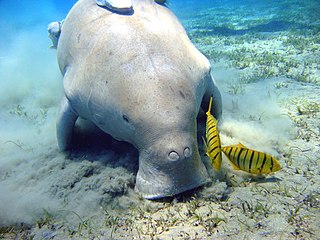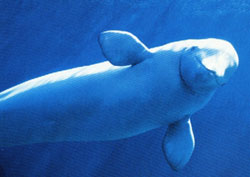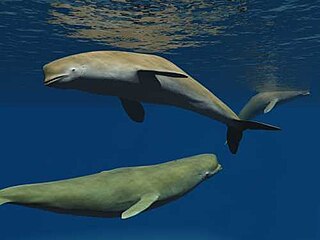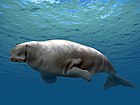
The Sirenia, commonly referred to as sea cows or sirenians, are an order of fully aquatic, herbivorous mammals that inhabit swamps, rivers, estuaries, marine wetlands, and coastal marine waters. The extant Sirenia comprise two distinct families: Dugongidae and Trichechidae with a total of four species. The Protosirenidae and Prorastomidae families are extinct. Sirenians are classified in the clade Paenungulata, alongside the elephants and the hyraxes, and evolved in the Eocene 50 million years ago (mya). The Dugongidae diverged from the Trichechidae in the late Eocene or early Oligocene.

Dugongidae is a family in the order of Sirenia. The family has one surviving species, the dugong, one recently extinct species, Steller's sea cow, and a number of extinct genera known from fossil records.

The cetacean family Monodontidae comprises two living whale species, the narwhal and the beluga whale and at least four extinct species, known from the fossil record. Beluga and Narwhal are native to coastal regions and pack ice around the Arctic Ocean. Both species are relatively small whales, 3–5 m (9.8–16.4 ft) in length, with a forehead melon, and a short or absent snout. Premaxillary teeth are absent. They do not have a true dorsal fin, but do have a narrow ridge running along the back, which is much more pronounced in the narwhal. They are highly vocal animals, communicating with a wide range of sounds. Like other whales, they also use echolocation to navigate. Belugas can be found in the far north of the Atlantic and Pacific Oceans; the distribution of narwhals is restricted to the Arctic and Atlantic Oceans.

Humiriaceae is a family of evergreen flowering plants. It comprises 8 genera and 56 known species. The family is exclusively Neotropical, except one species found in tropical West Africa.

Sirenia is the order of placental mammals which comprises modern "sea cows" and their extinct relatives. They are the only extant herbivorous marine mammals and the only group of herbivorous mammals to have become completely aquatic. Sirenians are thought to have a 50-million-year-old fossil record. They attained modest diversity during the Oligocene and Miocene, but have since declined as a result of climatic cooling, oceanographic changes, and human interference. Two genera and four species are extant: Trichechus, which includes the three species of manatee that live along the Atlantic coasts and in rivers and coastlines of the Americas and western Africa, and Dugong, which is found in the Indian and Pacific oceans.

Metaxytherium is an extinct genus of dugong that lived from the Oligocene until the end of the Pliocene. Fossil remains have been found in Africa, Europe, North America and South America. Generally marine seagrass specialists, they inhabited the warm and shallow waters of the Paratethys, Mediterranean, Caribbean Sea and Pacific coastline. American species of Metaxytherium are considered to be ancestral to the North Pacific family Hydrodamalinae, which includes the giant Steller's sea cow.

Nanosiren garciae is an extinct sirenian dugong that lived in warm shallow seas in what is now Venezuela, approximately 11.610—3.6 Ma during the Miocene and Pliocene. The species is listed in the Paleobiology Database, funded by the Australian Research Council.
Siquisiquesuchus is an extinct genus of gavialid crocodilian. It is known from cranial remains and a few postcranial bones found in Miocene-age rocks of the Castillo Formation in northwestern Venezuela.

Kutchisiren is an extinct genus of mammal which existed in what is now India in Khari Nadi Formation during the Miocene period. It was named by S. Bajpai, D. P. Domning, D. P. Das, J. Velez-Juarbe, and V. P. Mishra in 2010, and the type species is Kutchisiren cylindrica. It was originally named Kotadasiren gracilis in 1994, by Das and Basu.

Bohaskaia is an extinct genus of beluga-like odontocete cetacean known from the Early Pliocene of Virginia and North Carolina, United States. It was first named by Jorge Vélez-Juarbe and Nicholas D. Pyenson in 2012 and the type species is Bohaskaia monodontoides.
The Chandler Bridge Formation is a geologic formation in South Carolina. It preserves fossils dating back to the Chattian of the Paleogene period, corresponding to the Arikareean in the NALMA classification. The formation overlies the Ashley Formation and is overlain by the Edisto Formation.
The Parachucla Formation is a geologic formation in the southeastern United States. It preserves fossils from the Aquitanian stage of the early Miocene period. The formation is included in the Hawthorn Group. An exposure at the northern end of the formation has produced fossils estimated to be 19.4 to 20.5 Million years ago (Ma). Another exposure at the southern end of the formation has produced fossils estimated to be 23.9 to 24.7 Ma.
The Chagres Formation (Tc) is a geologic formation in the Colón Province of central Panama. The sandstones and siltstones were deposited in a shallow marine environment and preserve fossils dating back to the Middle to Late Miocene period.
The Lares Limestone is a geologic formation in Puerto Rico. It preserves fossils dating back to the Late Oligocene to Early Miocene period.
Scaphokogia is an extinct genus of pygmy sperm whales that lived off the coasts of Mexico and Peru, South America during the Late Miocene to Late Pliocene. Two species have currently been described: the type species S. cochlearis and S. totajpe. Fossils of Scaphokogia have been found in the Tirabuzon Formation of Baja California and the Pisco Formation of Peru. Scaphokogia existed about 5 million years ago, and were relatively rare animals.

Lentiarenium was an early sea cow from the Late Oligocene (Chattian) Linz-Melk Formation of Austria. Known since the mid 19th century, Lentiarenium was long considered to be a species of Halitherium until a 2016 analysis showed it to be distinct.

Mirocetus is a genus of archaic odontocete from the late Oligocene (Chattian) of Azerbaijan. Like many other primitive odontocetes, its classification has been fluid since its description.
Callistosiren is an extinct genus of mammal which existed in what is now Puerto Rico during the late Oligocene (Chattian).
Culebratherium is an extinct genus of dugongid sirenian mammal which existed in what is now Panama during the Early Miocene. It takes its name from the upper member of the Culebra Formation of the Panama Canal Zone, in which the holotype fossil was found.











